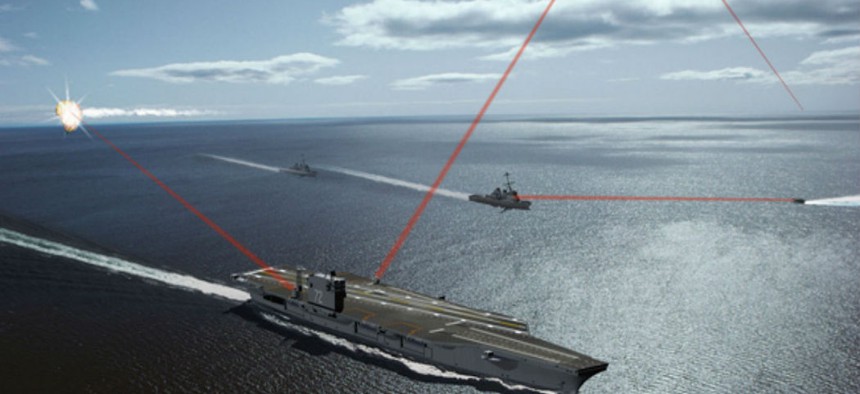U.S. Navy develops stronger lasers
High energy magazines power new shipboard weapons.
Having proved it can deploy and fire shipboard lasers, the U.S. Navy is moving at warp speed to develop lasers with more punch and power sources.
“We’re doing a lot more with lasers, Rear Adm. Ronald Boxall, director, Surface Warfare Division, said earlier this month at the annual Surface Naval Association national symposium.
The Navy plans to fire a 150-kw weapon off a test ship within a year, he said. “Then a year later, we’ll have that on a carrier or a destroyer or both.”
That’s quite a jump from the kw AN/SEQ-3(XN-1) Laser Weapon System (LaWS), which deployed in 2014 on the amphibious transport dock USS Ponce.
And the kind of power needed to power such a weapon won’t come with a simple flip of a switch.
“The Navy will be looking at ships’ servers to provide three times that much power,” says Donald Klick, director of business development, for DRS Power and Control Technologies. “To be putting out 150 kws, they (the laser systems) will be consuming 450 kws.”
That is more than most currently operational ships are designed to accommodate, at least when they are conducting other tasks. “Few power systems onboard ships can support sustained usage of a high-powered laser without additional energy storage,” noted a recent Naval Postgraduate School paper titled “Power Systems and Energy Storage Modeling for Directed Energy Weapons”.
The paper said, “The new DDG-1000 may have enough electrical energy, but other platforms … may require some type of ‘energy magazine.’ This magazine stores energy for on-demand usage by the laser. It can be made up of batteries, capacitors, or flywheels, and would recharge between laser pulses. The energy magazine should allow for sustained usage against a swarm of targets in an engagement lasting up to twenty minutes.
The DDG 1000 is built with what’s called a total ship computing environment, meaning software and blade servers manage not just the weapons systems on the ship but also handle the radar and fire control software and various logistical items such as water, fuel, oil and power for the ship, industry officials said.
The ship’s integrated power system, which includes its electric propulsion, helps generate up to 78 megawatts of on-board electrical power, something seen as key to the future when it comes to ship technologies and the application of anticipated future weapons systems such as laser weapons and rail guns. The ship’s electric drive uses two main turbine generations with two auxiliary turbine generators which power up two 35-megawatt advanced induction motors, developers explained.
Ideally, it would charge up as fast as it discharges, allowing for indefinite use (as long as there is ship’s fuel to expend). Low maintenance, high safety, and long lifespan are other desirable characteristics.
DRS Power and Control Technologies is one of the companies which is developing a specialized energy source. “We have enough for well over 100 shots before we go to recharge,” DRS’s Klick said during a break at SNA, pointing out there’s even a mode for continuous recharge. “If you’ve got power this kind of power, you don’t go Winchester.”
The DRS system uses a Li-Ion battery subsystem designed and provided by Lithiumstart housed in three distributed steel, welded cabinets that are 48” x 66” x 100” – although they are modular, Klick says, and can be arranged for a tailored fit. Each cabinet contains 18 drawers with 480 Li-Ion phosphate cells in each drawer.
The redundant power modules can provide 465 k each for a total of 930 kw. It can hold that full-power mark for about three minutes, Klick says – although most “lases” are normally of relatively short duration.
An at-sea demonstration of the magazine is slated for 2018, Klick says, mostly with the 150-kw laser being developed by Northrop Grumman for the Office of Naval Research.
The system still must go through rigorous Navy certification testing, Klick says.
He also sees the energy magazine as a candidate for other U.S. military units. “We’re looking at Air Force Special Forces on a C-130. You have to strike a car, but you’re worried about collateral damage. With that pinpoint accuracy, you don’t have to worry about collateral damage. You can just cause a car to stop running. There’s a lot more capability.”





